Life Explorers - The Human Senses Part II: Hearing
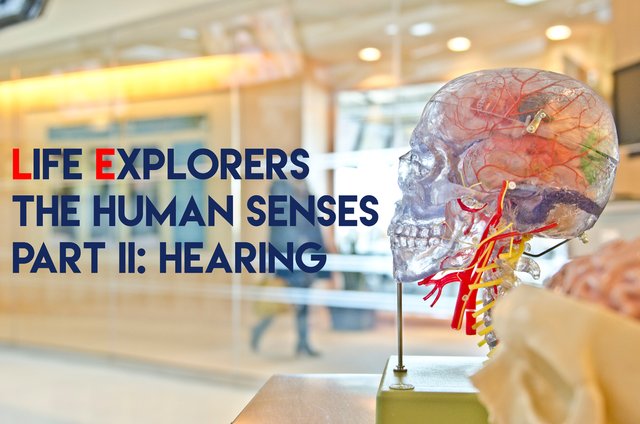
Many things around us and with us happen we take for granted. We see, feel, taste, hear and smell unknowingly how it works. As we were children we called anything into question and now accept reality as it is. We lost the magic in all these wonderful things. This series addresses the wonder of natures and will bring its magic back to light. The second part of the Life Explorers - The Human Senses deals with the sense of hearing. We hear and feel sounds, when getting older we steadily lose the ability to hear things like music, that makes us happy. Hearing is important in our daily life, we need it for communication and it can even affect how we feel.
To be able to understand why we hear we will investigate the nature and behavior of sounds, the human ear and the physical process behind hearing.
Just like the eye needs visible light to see, the ear needs sound to hear. Both sound and light are waves by their nature. The main difference is that light is an electromagnetic wave whereby sound a longitudinal, mechanical wave. To further understand the mechanics of hearing we need to have a look into the physics behind it. What is a mechanical wave and what does longitudinal mean?
Sound is created by a source that induces vibrations in a medium (air, water etc.). These sources are elastic materials, mostly solids, but also can be gases or liquids. By transferring the energy into the air particles the elastic material causes the molecules in the medium to get in motion. By moving the molecule forth it pushes a second molecule that gets in motion too. A chain reaction follows where the force is forwarded from the source through the molecules. You can imagine it this way:
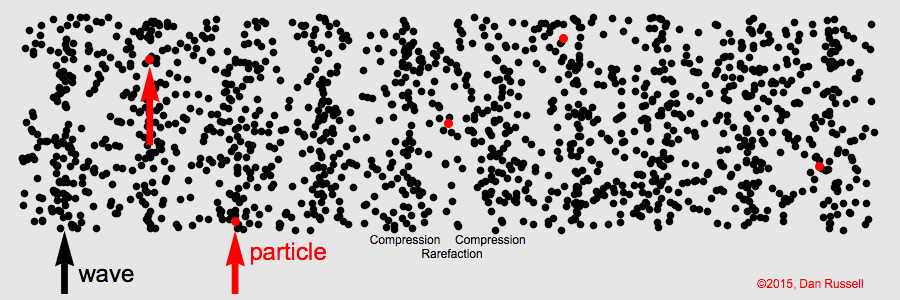
This is illustrating a longitudinal wave. Simply put, longitudinal means the particles are moving parallel to the wave. The opposite is a transverse wave, where the molecules move with a right angle to the wave.
The first molecule, however, moves back and repeats until moving back into his equilibrium state. This state is a condition where no forces influence the particle and it remains motionless. The molecules that are pushed back and forth, create a wave of areas of high and low pressure called compressions and rarefactions. The air density is higher at the compression area, because more molecule are located their, while the rarefaction area has a lack of molecules and therefore has a lower air density. The figure below illustrates the areas of high and low pressure of a typical sound wave.
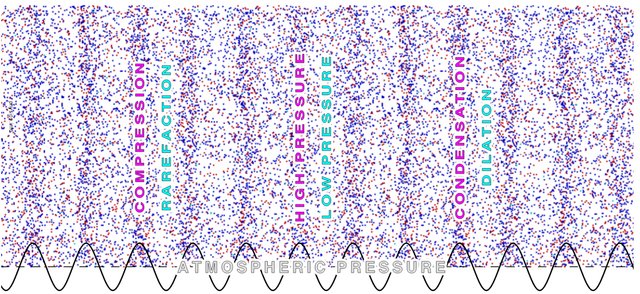
The absence of a medium renders it impossible to create a moving sound wave since there are no particles to pass the vibrations. R. BOYLES (1627- 1691) showed that this is the reason why we can’t hear in outer space.
Let’s have a closer look at the sound waves
Sound waves contain much information that is essential for distinguishing audible information. We will have a closer look at the basics of waves and how we can determine volume and pitch of a sound. Because waves occur periodically we will use the sine function to describe the sound waves. Sine functions are used whenever we want to describe something repeatable. The basic sine function is y(x) = sin (x)

So far so good, the above function describes the basic sine function, but as I said above sound contains many information. We need to adjust our sine function in order to better describe a sound wave. Sound can be loud or quite for instance or have a high or low pitch. To mathematically describe the volume of a sound we introduce the amplitude A. The amplitude is half the distance between the maximum and minimum values of the function and is vertically stretching the graph. The higher the amplitude the louder the actual sound we hear.
y = A * sin (x)
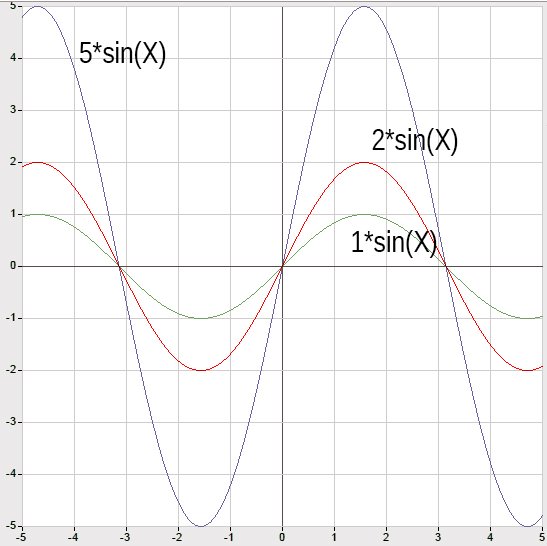
Another way to adjust the graph is by adding more or fewer cycles it completes in a certain time, the period B. The Period is stretching the graph horizontally and is responsible for the pitch. The less cycles the graph has the lower the pitch, therefore the pitch is higher with more cycles.
y = A sin (B*x)

In the last Life Explorers article we learned that lights travels with around 3.000.000 m/s, this is both right and wrong. The speed depends on the medium it’s traveling through. The following figure shows the speed of sound through different mediums in m/s
| Aluminum | Water | Air | Helium |
| 5110 | 1483 | 344 | 971 |
Why is the speed of sound in aluminum higher than in air?
As mentioned sound is created by a source of vibration. These vibrations, however, put molecules in motion by transferring energy from one molecule to another, a chain reaction happens. In solids, molecules have a rigid, fixed position and are packed very tightly. The air molecules are not rigid and have no fixed position. Transferring the energy from one molecule to another is easier in a solid than in a gas, since the next molecule is closer. This is the reason why sound waves move faster in solids. The greater the distance between sound source and hearer, the weaker is the sound wave, because of friction between the molecules the total energy is reducing.
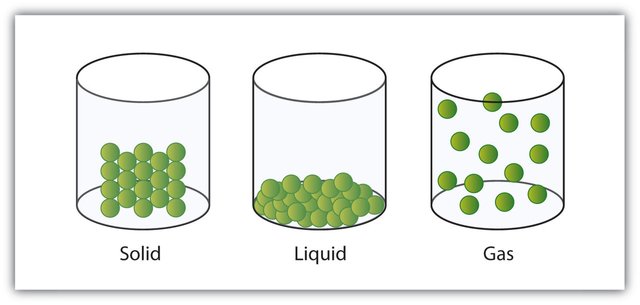
The human ear is capable of hearing frequencies between 20 Hz and 20.000 Hz. We saw that a small period causes a higher pitch and a high period a deeper pitch. The frequency tells us how many periods are made in a certain time. The higher the frequency the more periods are done. The following figure illustrates how the frequency and amplitude are affecting the sounds we hear.
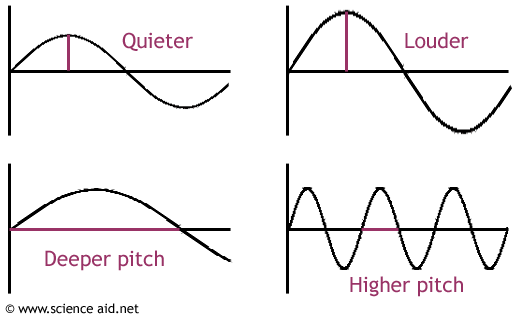
The frequency is given as f = 1/T. 20.000 Hz means 20.000 Periods are made in 1 second. Frequencies below 20 Hz are called infrasonic and above 20.000 Hz ultrasonic. Besides the having the right frequency we need to have the right loudness. The loudness depends on the amplitude and is measured in decibel. The lowest intensity the human ear can perceive is called threshold of hearing and is defined as 0 decibel. The intensity of sounds depends on:
- The source of vibrations
- The amplitude
- The medium though which the sound travels
- The distance between the source and observer
- Objects between the source and observer
- Interference
Interference happens when two sound waves combine. We have two possible ways to combine waves: constructive and destructive interference. Constructive interference increases the amplitude, whereas destructive interference compensate the waves.
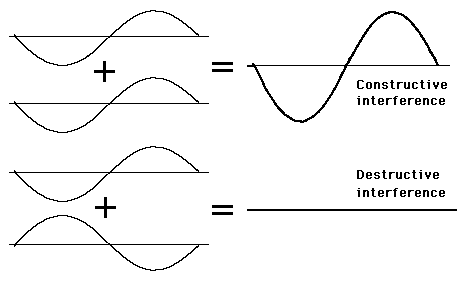
Now that we know more about waves let’s investigate how we hear and some sound phenomena
To understand how hearing works we need to know the structure of the human ear. The ear has three parts: The outer, middle and the inner ear. Each with it’s specific function.
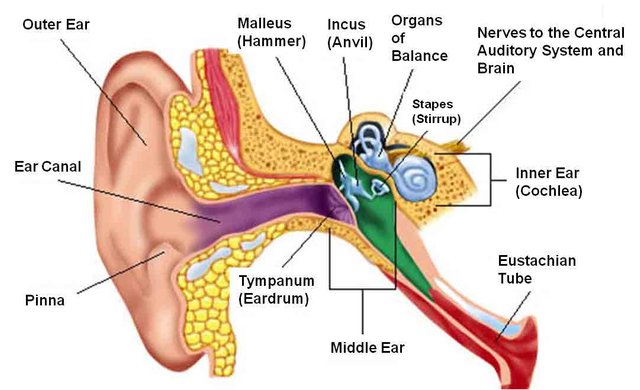
The outer ear
The outer ear is the only visible part of the ear. It reaches till the Tympanum (Eardrum). The function of the pinna is similar to a funnel, it directs sound waves into the inner parts of the ear. Another main role is in adjusting the pressure. Within the inner ear the air is compressed and has a higher pressure than outside. The pinna is lowering this pressure difference and makes sure that sound is passed correctly and with less waste of energy. By collecting the sound vibration and directing them into the ear it helps us to decide where a sound comes from. It also functions as a protection to the sensitive inner parts of the ear. It produces earwax, also known as cerumen, which protects again insects, water and bacteria. This way it is assisting in keeping the ear canal clean.
The middle ear
The middle ear begins with the Tympanum (Eardrum) and reaches to the cochlea (Inner ear). After the sounds waves are led by the pinna to the middle ear they hit the Tympanum which is a very thin diameter and make it vibrate. These vibrations are amplified in the middle ear and transferred to the ossicles, also known as the three middle ear bones: Malleus (Hammer), Incus (Anvil) and Stapes (Stiddrup). The last bones, the Stirrup is connected to membrane on the inner ear, called the oval windows.
The inner ear
This is the place where the actual hearing happens. It consists of the Cochlea, the organs of balance and nerves linked to the central auditory system and brain. The oval window is covering the Cochlea, which is filled with two fluids ( endolymph and perilymph). After the sound finds it's way into the inner ear it reaches the cochlea. Within the Cochlea is the organ of corti, which has tiny hairs. When the sound wave hits the eardrum it vibrates and these vibrations go to the middle ear bones. The Stirrup, the last bones, transfers these vibrations through the oval window and to the cochlea. The energy from these vibrations forces the fluid in the cochlea to move, in turn moving the hair in the organ of corti. The movement of these hair causes nerve impulses which are sent to the brain and finally are converted to what we hear.
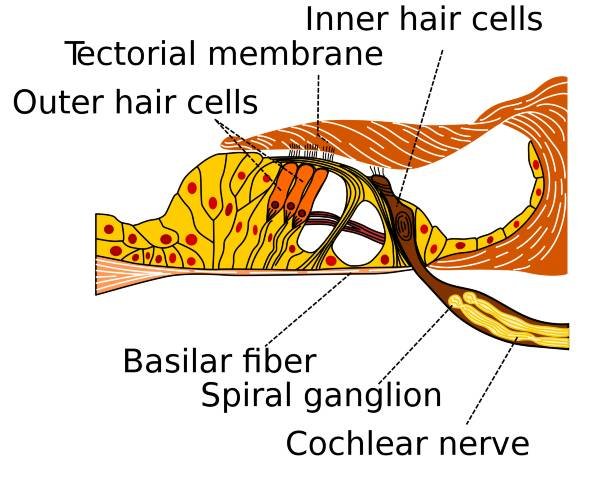
Applying science in our daily lifes
By observing the nature we can adapt and use the physics to our benefits. Following are some practical use of sound waves:
Doppler Effect:
The Doppler effect is named after the Austrian physicist Christian Doppler and describes a moving source of sound waves towards an observer. The observer perceives higher frequencies when the source if moving towards, and lower frequencies when moving away from the observer. A common example is the siren of police and ambulances. When approaching towards us we hear a higher “sound” and when passing by it decreases in its frequency.
The reason behind this effect is in the development of sound waves. When the wave is originated it still has to travel to the observer. The nearer the source means a shorter period for a wave to hit our ears, and the higher the frequency.
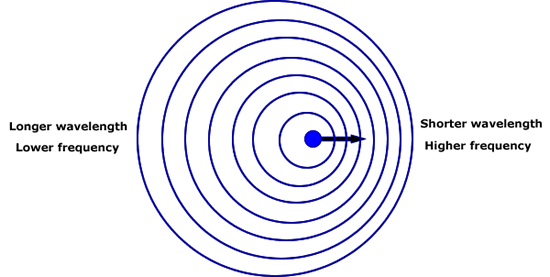
Cymatics:
Cymatics are pretty cool! The Swiss Hans Jenny took a plate and put a thin layer of particles on it. The same works with a liquid or similar. Then he set the plates into oscillation and tried different frequencies. While it's best to just watch the video and be amazed, the basic idea is that different frequencies organize into different shapes. (Note: This video is not from Hans Jenny):
<iframe width="560" height="315" src="
Sonography:
Simply put Sonography uses ultrasound to display the internal body. Frequencies over 20.000 Hz are used in this method. Our tissues reflect these ultrasonic waves differently, depending on the density. Bones reflect the waves differently than muscles do. The echo of the tissue is recorded and processed to an image.

Author's Note:
The Life Explorer Series is a community magazine that brings together writers to post about a variety of topics. All topics and authors using the lifeexplorer tag or title are part of this group and have permission to post under the heading Life Explorer. If you would like to write with the Life Explorer series about a topic, reach out and get in chat contact with @timsaid to learn more.
Make sure to catch all these Life Explorer authors:
@prufarchy
@yogi.artist
@disofdis
And if you've missed the previous edition, check out the first Life Explorer post:
Life Explorers - The Human Senses Part I: Sight

This is an AMAZING posting and it surely touches me as I am a big fan of the subject as well. Thank you so much for the quality and dedication to this sharing, it is greatly appreciated. Namaste :)
Thank you! Check out the other Life Explorer posts :)
Thank you, @timsaid, for such a thorough post. I wish I could understand how to get my hearing back in my left ear. It's some kind of nerve damage. By looking at the pictures I have a feeling I know exactly what the problem is. It's mind boggling how complicated the senses are.
Hey @fairytalelife, glad to read your words. Since when can't you hear on your left ear? As technology and science develops faster I really hope that you will gain your hearing back! Isn't it fascinating how humans evolved? From stones and wood sticks to understanding how atoms work
Since 2008! Nothing showed up on the MRI - frustrating
Hello Tim, was nice to meet you in Hamburg :-) So I love to comment on your well rounded and nicely set up post about HEARING. Thank you! There is nothing to add or correct regarding your information. The only thing I want to mention is something natural science (by definition) leaves out - the factor of subjective experience. Before I forget it, I want to refer to a wonderful sensual video of one of my favorite acappella groups which your CYMATICS - video reminded me to.
STARS by VOCES8
I am a medical doctor by profession working mainly with homoeopathy which works. I experience it working every day with my patients since now nearly 30 years. But it cannot be explained in terms of physics etc. So natural science up to now does not have a real understanding of what we are dealing with. But from my day to day experience it can be better understood by the term RESONANCE which is something we can share here. This term is very central to physics and somehow can also refer to subjective experience. Listening to music which is something different than hearing it, especially with me listening to well developed human vocals goes beyond physics and can at times miraculously establish this well known goose-pimples-experience you also might have experienced. A good performance sometimes catches you and triggers something in the whole body-soul-being without cognitive understanding. CYMATICS also made it! So there is something beyond transversal sound waves. They are the the all important medium, but in service of carrying the real secret. - Your article triggered quite some ideas for more but would need a post by itself. Thanks Tim!
Hey buddy!
Hope to see you again soon :) Sciene is so fascinating! It describes our life and everything and yet we know so little! Basically we know knowing! I hope to live long enough to see new ground breaking things
Amazingly great post!!!
I know almost all, but read it with a pleasure! :)
I'm unhappy person who still can hear ultrasound.
Batman!
lol!
but I can hear bats :)
Cymatics are pretty cool! 你绝对是天才,i am chinese,i love you.
interesting article, I wonder why you didn't shed more light to the role played by the brain but thanks!
I am about to write an article about the neuronal activities that play a key role in transmitting signals. The process itself has enough room for several posts :) Step-by-step. But thanks for your reply, shows that there is interest in reading more
great, I am a big brain fan, good luck with your article :)
Thank you for sharing. I did not think I could learn as much from Steemit as I have today, particularly as I struggle with my own hearing and strive to understand it.
Hope your hearing will get better soon
Thank you for sharing this material, I like what you posted. Thank you so much
Really great post! I follow you!
Very cool! Big science fan. That video is absolutely astounding, showing the impact sound has on liquids and solids.
That video totally got me! It's art and science